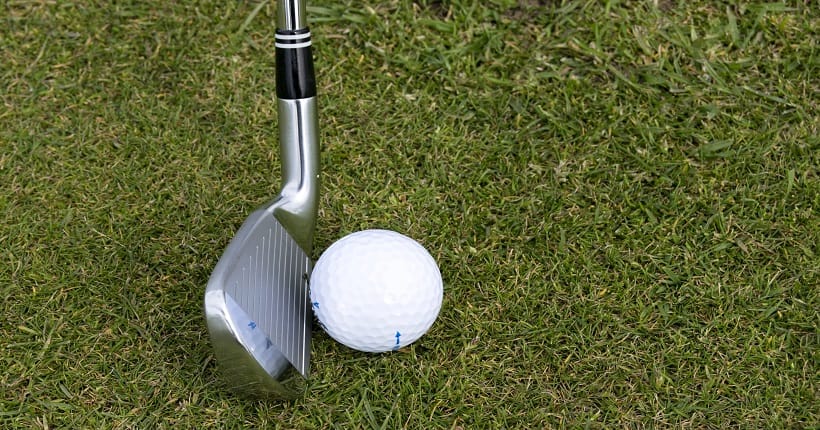How Much Does A Golf Club Weigh?
A golf club typically weighs between 12 and 17 ounces, depending on its type and materials used. Golf clubs come in various weights based on their design and components.
Factors Affecting Golf Club Weight
Golf clubs come in a variety of weights, and understanding the factors that contribute to their weight can help golfers choose the right club for their swing and playing style. Several key factors influence the weight of a golf club, including the clubhead material and design, the shaft material and length, and the grip weight and thickness. Let’s take a closer look at each of these factors and how they impact the overall weight of a golf club.
Clubhead Material and Design
The material and design of the clubhead play a crucial role in determining the weight of a golf club. Different materials used in clubheads include steel, titanium and carbon fiber. These materials have varying densities, which directly affect the weight of the club. Steel clubheads are typically heavier than titanium or carbon fiber clubheads. The design of the clubhead can also impact weight. For example, cavity-back clubheads tend to have a larger sweet spot and higher forgiveness, but they are usually heavier than blade-style clubheads.
Materials Used in Clubheads
Clubheads are typically made of various materials, each with its own weight characteristics. Here are some common materials used in clubheads:
- Steel: Steel clubheads are known for their durability and solid feel. They are heavier than other materials, providing a more stable swing.
- Titanium: Titanium clubheads are lighter but still offer strength and forgiveness. They can improve swing speed and increase distance.
- Carbon Fiber: Carbon fiber clubheads are the lightest option, allowing for faster swing speeds. They are often used in drivers for maximum distance.
Impact of Clubhead Design on Weight
The design of the clubhead can also affect its weight. Cavity-back clubheads have a hollowed-out back, which redistributes weight to the perimeter. This design increases forgiveness but typically adds weight to the club. On the other hand, blade-style clubheads have a solid back and are generally lighter. The design you choose will depend on your playing style and personal preference, but it’s essential to consider the impact on weight when making your selection.
Shaft Material and Length
The material and length of the shaft also contribute to the overall weight of a golf club. Common materials used in shafts include graphite and steel. Graphite shafts are lighter than steel shafts and can enhance swing speed. However, steel shafts provide more control and stability. Additionally, the length of the shaft plays a role in weight. Longer shafts tend to be heavier than shorter shafts, so it’s crucial to find the right balance for your swing.
Different Materials Used in Shafts
Shafts are typically made of either graphite or steel. Here’s a breakdown of each material:
| Graphite Shafts | Steel Shafts |
|---|---|
| Lightweight | Heavier |
| Enhances swing speed | Provides control and stability |
| Shock-absorbing | More durable |
Length of Shaft and its Effect on Weight
As mentioned earlier, the length of the shaft can impact the weight of a golf club. Longer shafts are generally heavier since they require more material. It’s essential to consider the trade-off between distance and control when deciding on the length of the shaft. A longer shaft may enable you to generate more distance, but it could also make the club more challenging to control.
Grip Weight and Thickness
The weight and thickness of the grip also contribute to the overall weight of a golf club. Grips are typically made of rubber, synthetic materials, or various combinations. Different types of grips have varying weights, with some being heavier than others. It’s crucial to choose a grip that feels comfortable and secure in your hands while also considering its impact on the club’s weight.
Types of Grips and their Weights
Here are some common types of grips and their average weights:
- Standard Grip: Standard grips are the most common and typically have a moderate weight.
- Oversized Grip: Oversized grips are larger and give players a more secure and relaxed grip. They tend to be heavier than standard grips.
- Undersized Grip: Undersized grips are thinner and lighter than standard grips. They are suitable for players with smaller hands or those seeking more feedback from the club.
- Corded Grip: Corded grips have added texture and are popular among players who prefer a firm grip. They are typically lighter than oversized grips.
Impact of Grip Thickness on Overall Club Weight
The thickness of the grip can impact the overall weight of a golf club. Thicker grips add more weight to the top end of the club, potentially influencing the swing dynamics. Thinner grips, on the other hand, reduce weight and can change the feel of the club. It’s important to find the right grip thickness that allows you to maintain control and feel comfortable throughout your swing.
When it comes to choosing the right golf club, understanding the factors that affect weight is crucial. The clubhead material and design, shaft material and length, as well as grip weight and thickness all play a role in determining the overall weight of a golf club. By considering these factors and finding the right balance for your swing, you can optimize your performance on the golf course.

Credit: jsgolfcarts.com
General Weights Of Different Types Of Golf Clubs
Understanding the weight of each golf club can significantly impact your playing style and overall performance on the golf course. Each type of golf club has its own unique specifications and weight range, allowing golfers to choose the perfect club for their swing and game. In this article, we will explore the general weights of different types of golf clubs, including drivers and woods, irons, wedges and approach irons, and putters.
Drivers and Woods
Drivers and woods are designed to provide maximum distance off the tee, and their weight plays a crucial role in achieving this goal. While the weight of these clubs can vary depending on the brand and model, there are specific weight ranges to consider.
Typical Weight Ranges for Drivers
The weight of drivers typically falls between 280 grams and 310 grams. This range allows golfers to find the perfect balance between control and distance. Heavier drivers can provide more stability and control, while lighter drivers can help increase clubhead speed, resulting in longer drives.
Average Weight of Fairway Woods
Fairway woods are versatile clubs that can be used both off the tee and from the fairway. These clubs are generally lighter than drivers, with an average weight of around 200 grams. This lighter weight allows golfers to generate more clubhead speed and launch the ball higher, making it easier to hit off the ground.
Irons
Irons are essential for accuracy and control on the golf course. They allow golfers to shape shots and hit precise distances, making them vital for approach shots and greenside play. The weight of irons can vary depending on the specific club and set makeup.
Weight Ranges for Different Irons
Iron sets typically consist of a range of numbered irons, with each iron having a slightly different weight. Here are the weight ranges for different irons:
| Iron Number | Weight Range (grams) |
|---|---|
| 3 Iron | 215-235 |
| 4 Iron | 220-245 |
| 5 Iron | 225-250 |
| 6 Iron | 230-255 |
| 7 Iron | 235-260 |
| 8 Iron | 240-265 |
| 9 Iron | 245-270 |
As the number of the iron increases, the weight tends to decrease slightly. This weight progression allows for better control, precision, and playability as golfers move closer to the green.
Average Weight of Wedges and Approach Irons
Wedges and approach irons are designed to give golfers better control and versatility around the green. These clubs are generally heavier than the irons in the set, with an average weight ranging from 260 grams to 300 grams. The added weight helps golfers produce more spin and control for shots that require finesse and accuracy.
Putters
The weight of a putter can significantly impact a golfer’s feel and stroke on the greens. Finding the right putter weight is crucial for consistency and putting performance.
Different Putter Weight Options
Manufacturers offer putters in various weight options to accommodate different preferences and putting styles. The range of putter weights typically falls between 330 grams and 370 grams. Lighter putters allow for a smoother, more controlled stroke, while heavier putters can enhance stability and accuracy.
Factors to Consider when Choosing Putter Weight
When selecting a putter weight, there are a few factors to consider:
- Your stroke type: If you have a more arcing stroke, a heavier putter may be beneficial. For a straight-back, straight-through stroke, a lighter putter could work better.
- Green speed: Faster greens may require a lighter putter to help with speed control, while slower greens may benefit from a heavier putter for added feel.
- Personal preference: Ultimately, choosing a putter weight comes down to personal preference and what feels most comfortable in your hands.
By considering these factors, you can find the perfect putter weight to improve your putting and enhance your overall game.
Significance Of Golf Club Weight And How It Affects Performance
Golf club weight is a crucial factor that can greatly impact a player’s performance on the course. The weight of a golf club plays a significant role in various aspects of a golfer’s swing, distance, accuracy, control, consistency, and feel. Understanding how club weight influences these factors can help golfers make informed decisions when selecting the right equipment for their game.
Swing Speed and Distance
One of the key aspects affected by golf club weight is swing speed and ultimately, shot distance. The weight of the clubhead directly affects how fast a golfer can swing the club. A lighter clubhead requires less effort to swing, resulting in increased swing speed. Conversely, a heavier clubhead may require more strength and effort to swing, potentially reducing swing speed.
Impact of Heavier and Lighter Clubheads on Swing Speed
The weight of the clubhead can have a profound impact on swing speed. A lighter clubhead enables golfers to generate higher swing speeds, which can result in increased distance. On the other hand, a heavier clubhead can offer more control and stability during the swing but may sacrifice some speed. Finding the right balance between swing speed and control is essential to optimize performance.
Relationship between Club Weight and Shot Distance
The weight of the club affects shot distance in conjunction with swing speed. While a lighter clubhead may increase swing speed, if it causes a loss of control, the resulting shot may not carry the desired distance. Conversely, a heavier clubhead may provide more control but may limit swing speed, potentially reducing distance. It is crucial to find the optimal weight that maximizes both speed and distance for individual players.
Accuracy and Control
Club weight also plays a vital role in accuracy and control during the swing. The weight of the club influences how the player positions and controls the clubhead, affecting the accuracy of their shots. A club that is too heavy or too light can alter the golfer’s swing path and lead to inconsistent strikes. Finding the right balance of weight allows for better club control and improved accuracy on the course.
Influence of Club Weight on Accuracy
The weight of the golf club can significantly impact accuracy. A heavier clubhead can provide more stability and control, allowing golfers to maintain a more consistent swing plane and strike the ball with precision. Conversely, a lighter clubhead may offer increased maneuverability but can be more challenging to control, resulting in inconsistent shots. Golfers must consider their skill level and swing mechanics when selecting a club weight that promotes accuracy.
Controlling Shot Shape with Different Club Weights
By adjusting the weight of the golf club, players can also influence the shape of their shots. A lighter clubhead allows for more maneuverability, making it easier to shape shots like fades or draws. On the other hand, a heavier clubhead promotes a more straightforward and controlled swing, ideal for players looking for a consistent shot shape. The weight of the club becomes a crucial tool in helping golfers achieve the desired shot shape based on individual preferences and course conditions.
Consistency and Feel
Another area where club weight plays a significant role is in consistency and feel. A golfer’s ability to consistently repeat a swing tempo is essential for reliable performance. The weight of the club influences the tempo of the swing, and finding the right weight allows golfers to maintain a consistent rhythm throughout their round.
Consistency with Club Weight and Swing Tempo
The weight of the club affects swing tempo by influencing the golfer’s timing and rhythm. A heavier clubhead may promote a slower tempo, while a lighter clubhead can lead to a quicker tempo. Consistency in swing tempo not only improves shot performance but also enhances overall muscle memory and coordination.
Importance of Weight in Achieving the Desired Feel
The weight of a golf club is instrumental in achieving the desired feel for players. Different golfers have different preferences when it comes to club weight, and finding the right weight is crucial for comfortable and confident swings. The right weight can instill a sense of balance, control, and satisfaction, allowing golfers to fully express their skills and enjoy the game.
As golfers strive to improve their game, understanding the significance of club weight and how it affects various aspects of performance is essential. By considering swing speed, distance, accuracy, control, consistency, and feel in relation to club weight, golfers can make informed decisions when selecting the ideal golf clubs to enhance their skills and enjoyment on the course.
Frequently Asked Questions Of How Much Does A Golf Club Weigh?
How Much Do Golf Clubs Weigh For Flying?
Golf clubs for flying typically weigh around 20 to 25 pounds.
What Is The Club Weight?
The club weight refers to the weight of a golf club, which affects the swing and distance.
How Much Does An Iron Club Shaft Weigh?
An iron club shaft typically weighs around 85 to 125 grams.
What Weight Are Women’S Golf Clubs?
Women’s golf clubs come in various weights, depending on the type and brand, typically ranging from 1. 8 to 2. 5 pounds.
How Much Does The Average Golf Club Weigh?
The average golf club typically weighs between 275 to 310 grams, depending on the type and material used.
Conclusion
After delving into the weight of golf clubs, it’s clear that this aspect plays a significant role in a golfer’s game. By understanding the different weights of clubs, players can make informed decisions about which ones to use for specific shots.
While the standard weight of a golf club varies depending on the type, material, and individual preferences, it is generally accepted that lighter clubs provide greater clubhead speed and distance, while heavier clubs offer more control and accuracy. It’s also important to consider the golfer’s physical abilities, swing speed, and playing style when selecting the right club weight.
Ultimately, finding the right balance between distance and accuracy is key. With this knowledge, golfers can optimize their performance on the course and enjoy the game even more. So, the next time you step onto the green, take a moment to appreciate the impact that weight has on your golf clubs and use it to your advantage.
Happy golfing!







